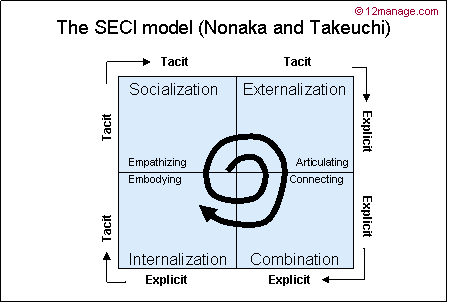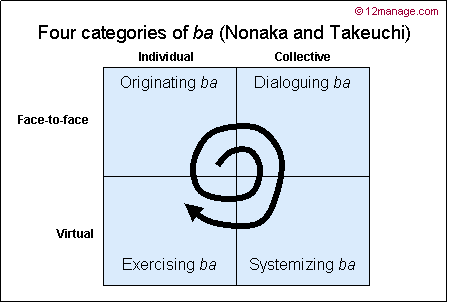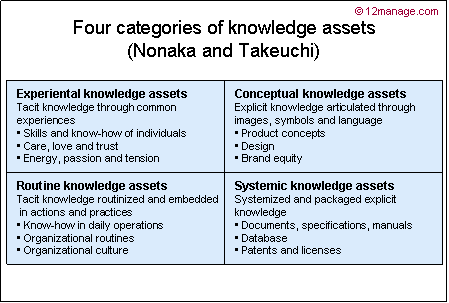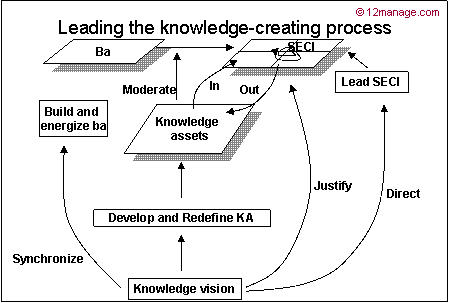¿Qué es el Modelo SECI?

Ikujiro Nonaka y Hirotaka Takeuchi proponen un modelo de proceso de creación de conocimiento para entender la naturaleza dinámica de la creación del conocimiento, y para manejar tal proceso con eficacia: el Modelo SECI. Consiste en 3 elementos:
- SECI
- Ba
- Activos de conocimiento
Estos 3 elementos interactúan con cada uno de los otros orgánico y dinámicamente. Los activos del conocimiento de una organización se movilizan y se comparten en “Ba” mientras que el conocimiento tácito llevado a cabo por los individuos es convertido y amplificado por el espiral del conocimiento a través:
- Sociabilización
- Externalización
- Combinación
- Internalización
Los tres elementos se deben integrar bajo liderazgo sin obstrucción de modo que la organización pueda crear conocimiento contínuo y dinámicamente: debe convertirse en una disciplina para los miembros de organización.
SECI
La creación del conocimiento es un proceso contínuo de interacciones dinámicas entre el conocimiento tácito y el explícito. Los cuatro modos de la conversión del conocimiento interactúan en una espiral de creación del conocimiento. El espiral llega a tener una escala más grande cuando se eleva a través de los niveles de organización, y puede activar nuevos espirales de creación de conocimiento.

Sociabilización. Compartir el conocimiento tácito a través de una comunicación cara a cara o de la experiencia compartida. Un ejemplo es el aprendizaje.
Externalización. Desarrollando conceptos, que encajan con el conocimiento tácito combinado. Y que permiten su comunicación.
Combinación. Combinación de varios elementos del conocimiento explícito: la construcción de un prototipo es un ejemplo.
Internalización. Cercanamente ligada al aprendizaje en acción, el conocimiento explícito se convierte en parte de la base del conocimiento individual (e.g. modelos mentales) y se convierte en un activo para la organización.
Ba
Este dificultoso concepto (no hay traducción exacta de la palabra) se puede definir como un contexto compartido en el cual se comparta el conocimiento, creado y utilizado a través de la interacción.
El diagrama ilustra los varios tipos de Ba, cada uno ofrece un contexto para un paso específico en el proceso de creación de conocimiento.
Ejemplos de las categorías, usando como ejemplo Seven-Eleven (tiendas japonesas de conveniencia):
- Originando el Ba: el piso de la tienda, permite a la gente interactuar con cada uno de los otros y con los clientes.
- Dialogado Ba: el conocimiento tácito de los empleados del local se utiliza para crear pronósticos de ventas, en diálogo con cada uno de los otros.
- Sistematización del Ba: los pronósticos de ventas se prueban contra los resultados de ventas y se retroalimentados hacia los almacenes locales.
- Ejercitar el Ba: usando esta información, y comparándola con la realidad, el personal mejora sus habilidades y su capacidad de hacer pronósticos.
Activos de conocimiento

Éstos son recuros específicos para la compañía que son imprescindibles para crear valor para la firma. Son las entradas, salidas, y los factores de moderación, de creación del proceso de conocimiento.
Para manejar con eficacia la creación y explotación del conocimiento, una compañía tiene que “mapear” su inventario de activos de conocimiento. La catalogación sin embargo no es suficiente: los activos del conocimiento son dinámicos; los activos del nuevo conocimiento se pueden obtener a partir de activos de conocimiento preexistentes.
El papel de la dirección se ilustra en el siguiente diagrama:

Origen del Modelo SECI. Historia
El modelo de Nonaka y de Takeuchi se basa en de Polanyi la distinción entre el conocimiento tácito y explícito (1983) y proporciona una comprensión de la creación y de la gestión del conocimiento de una perspectiva japonesa de la cultura del negocio.
Fortalezas del Modelo SECI. Beneficios
- Aprecia la naturaleza dinámica del conocimiento y de la creación del conocimiento.
- Proporciona un marco para la gerencia de procesos relevantes.
Limitaciones del Modelo SECI. Desventajas
- Se basa en un estudio de las organizaciones japonesas, que confían fuertemente en el conocimiento tácito: los empleados están a menudo con una compañía para toda la vida.
- La linealidad del concepto: ¿puede el espiral saltar pasos? ¿Puede ir hacia la izquierda?
Libro: Ikujiro Nonaka, Hirotaka Takeuchi - The Knowledge-Creating Company
|
Grupo de Interés Especial
|
|
|
|
Discusiones en el Foro sobre Modelo SECI.

|
SECI for Integration Between ETOM and KM System
The SECI model has been implemented in many industries.
The Telecom industry has eTOM as business process framework with critical knowledge in each level of processes.
A specific effort is need to i...
 7 |

|
History of Knowledge Management
I found that other models and concepts came after SECI model. Referring to history,
- "Since 1975, the knowledge management (KM) related developments have been the emerging subject in organizations"...
 5  1 comentarios |

|
Linking SECI Model to Innovation
I have some thoughts on how Knowledge Management and Innovation are linked... There are a number of models for implementing innovation. A simple model that I like involves 5 steps:
1. Idea Generation...
 4  2 comentarios |

|
SECI Software Tools?
Hi Everybody. I am looking for a software solution to support a SECI implementation.
Does anybody has a software product in mind? One based on SECI model?
Best regards......
 4  2 comentarios |
|
|
|
Cursos sobre Modelo SECI.

Curso de Iniciación
|

Curso Avanzado
|

Curso para Expertos
|
|
|
|
Los temas mejor valorados sobre Modelo SECI. Aquí encontrará las ideas más valiosas y sugerencias prácticas.
|
|
|
Conocimientos avanzados sobre SECI model (Inglés). Aquí encontrará consejos profesionales de expertos.

Consejos de Consultoría
|

Consejos de Enseñanza
|

Consejos Prácticos de Implementación
|
|
|

|
Barriers that Hinder Effective Knowledge Sharing Effective Knowledge Sharing, Pitfalls to Avoid, Knowledge Management Implementation
According to Chris Collison, there are seven common barriers or syndromes that hinder effective knowledge sharing and se...
|

|
9 Major Definitions of Knowledge Management Knowledge Management
- KM is the "process of collecting, organizing, classifying and disseminating information throughout an organization, so...
|

|
How to Identify and Map Knowledge Knowledge Identification, Knowledge Capturing, Knowledge Storage
In his article “Knowledge Mapping: The Essentials for Success”, Wesley Vestal provides following six tips to identify an...
|

|
The N-Form Organization (Hedlund) Alternate KM Framework
Gunnar Hedlund of the Stockholm School of Economics introduced the notion of the N-Form corporation in 1994. He proposed...
|

|
Critical Activities to Build a Learning Organization Implementing Organizational Learning, Best Practices
Learning organizations are distinguished because they are undertaking certain activities to foster the internal learning...
|

|
Capturing Learned Lessons How to Capture Organizational Learning? Best Practices
Knowledge from bad and good experiences will lead you and your organization to better future performance. You can improv...
|

|
Knowledge Management Scope Knowledge Management, Level of Know-how
Research by Deishin Lee (HBS) and Eric Van den Steen (MIT) shows that recording mediocre know-how can actually be counte...
|

|
Three Pillars of Knowledge Management (WiiG) Alternate KM Framework
Karl Wiig is one of the pioneers in the field of Knowledge Management and was among the first to publish a series of tex...
|

|
Components of Learning Agility Organizational Agility, Organizational Learning, Knowledge Management
One of the critical factors for achieving organizational agility is learning agility, which refers to the ability and ea...
|

|
Positive Effects of Age Diversity on Company Productivity and (Tacit) Knowledge Sharing Tacit Knowledge Transfer, Workforce Productivity, Incentive Management
Backes-Gellner and Veen (2013) outlined the main advantages of having a diverse workforce within a company. The followin...
|

|
Knowledge Management Focal Point Knowledge Management Focus
Research by Deishin Lee (HBS) and Eric Van den Steen (MIT) shows that information about successes is typically more usef...
|
|
|
|
Varias fuentes de información sobre Modelo SECI. Aquí encontrará powerpoints, videos, noticias, etc. para usar en sus propias conferencias y talleres.

|
Revisiting Knowledge Management Integrating Knower with the Knowledge Processes
Very good paper by Madhukar Shukla gives historic overview of KM, 3 dimensions of KM and future directions of KM....
|

|
How Businesses can Use Information Technology (IT) in Strategic Ways Strategic Management, Information Technology
This presentation looks at Information Technology from a strategic point of view. In other words, it discusses in what w...
|

|
People and Latent Knowledge in Organizational Learning Knowledge Creation, Explicit Knowledge, Tacit Knowledge
Knowledge management theory has struggled with the concept of knowledge creation. Since the seminal article of Nonaka in...
|

|
How to Improve Knowledge Sharing in Knowledge-intensive Organizations Knowledge Management, Knowledge Sharing Motivation, Knowledge Sharing Platform. Tacit Knowledge
This presentation elaborates on the concept of knowledge sharing, thereby focusin on a knowledge-intensive organization ...
|

|
Introduction to Knowledge Management: Foundation Principles and Building Concepts Knowledge Management, Knowledge Sharing, Learning Organization
1. What is Knowledge?
1. What is Knowledge Management? Definition
2. Knowledge Foundation Principles and Building Conc...
|

|
Knowledge Transfer and Knowledge Sharing Knowledge Management, Knowledge Sharing, Knowledge Transfer
Preentation that is an introduction into the concept of Knowledge Transfer, including its fundamentals, strategies, guid...
|

|
Overview of Existing Types of Knowledge Knowledge Management, Knowledge Types, Tacit, Implicit, Explicit, Declarative, Procedural Knowledge
This presentation provides an overview of the different types of knowledge that exist. The presentation includes the fol...
|

|
Knowledge Management Systems Architecture Knowledge Management, Knowledge Creation, Knowledge Systems, Knowledge Architecture
This presentation is about knowledge development and management, including the following sections:
1. Overview
2. Know...
|

|
How to Integrate Internal Organizational Knowledge with External Online Communities Knowledge Management, Knowledge Creation, Knowledge Sharing, Interaction, Knowledge in Organizations
Due to many online and web-based technological developments in today´s digital economy, sharing knowledge in online comm...
|

|
Leveraging Cognition for Competitive Advantage:A Knowledge-Based Strategy Process Knowledge-intensive firms
Article by Senthil K. Muthusamy and Ramaraj Palanisamy. One of the central bases for achieving competitive advantage is ...
|

|
Discovering Knowledge Management Forces Healthcare
This paper by Khalid Samara is an ongoing research in the area of knowledge management (KM) and evidence-based practice ...
|

|
Introduction and Summary of SECI Initial Understanding of SECI. Start of workshop/training
Knowledge Management
Is utilizing tacit (the unseen huge part of the iceberg), as well as explicit (the tip of the iceb...
|

|
Knowledge Creation: The SECI Model Knowledge Management, Knowledge Creation
Presentation about the SECI model of Nonaka and Takeuchi (1996), a model about knowledge creation. The model is based on...
|

|
Knowledge Sharing and Organizational Learning through Communities of Practices Knowledge Sharing, Organizational Learning, Communities of Practices, Special Interest Groups
Knowledge management in Communities of Practice (CoPs)
This presentation is about organizational learning and knowledge...
|

|
SECI Model Diagrams Knowledge Management
Download and edit these 12manage PowerPoint graphics for limited personal, educational and business use.
Republishing i...
|

|
Knowledge Transfer in the E-world Knowledge Management, Knowledge Transfer, Internet, Intranet, E-Business, CRM
This is a presentation about Knowledge Transfer (KT), specifically focused on KT in the e-world. The presentation consis...
|

|
3 Pillars of KM Knowledge Management
Three Pillars of Knowledge Management (Wiig)....
|

|
N-Form Organization Knowledge Management
The Dynamics of Knowledge Management in an N-Form Organization....
|
|
|
|
Herramientas útiles sobre Modelo SECI.

Noticias
|

Vídeos
|

Presentaciones
|
| |

Libros
|

Académico
|

Más
|
|
|
|
Compare el Modelo SECI, con: Modelo de la Creación del Conocimiento | Aprendizaje Organizacional | Memoria Organizacional | Aprendizaje Activo | Gestión del Conocimiento (Collison y Parcell)
Vuelva a la página principal de Administración: Conocimiento e Intangibles | Liderazgo
Más Métodos, Modelos y Teoría de la Administración
|
|
|
Grupo de Interés Especial
|
|
|
|
















